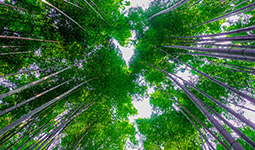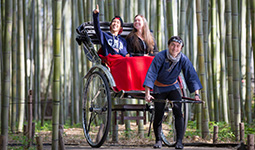August 2022
- English
- 日本語
Two Paths through the Bamboo in Sagano, Kyoto

A rickshaw on the Bamboo Forest Trail 
Chikurin-no-Komichi in Kyoto. The “Path of bamboo” is lined with hogaki bamboo fences

Towering bamboo along the Chikurin-no-Komichi, or “Path of bamboo” 
Visitors enjoy a rickshaw ride on the Bamboo Forest Trail

Sagano*, in the western part of Kyoto City, is famous for its bamboo forest and the path through it, the Chikurin-no-Komichi, or “Path of bamboo.” In 2015, another spot, called the “Bamboo Forest Trail,” opened nearby, where visitors can also enjoy the beauty of bamboo.

Located in the western part of Kyoto City, the Sagano area is known for its beautiful bamboo forest, popularly known as the Arashiyama Bamboo Grove. The forest is about a 10-minute walk from JR Saga-Arashiyama Station, which is a 17-minute train ride from JR Kyoto Station. In the forest, there is a 400-meter path from Nonomiya Shrine in the middle of the forest through the north gate of Tenryu-ji Temple that leads to the beautiful Okochi Sanso villa. Called the Chikurin-no-Komichi, or “Path of bamboo,” it is one of Kyoto’s most popular sightseeing spots.
Recently, another area extending north from the Nonomiya Shrine, close to Tenryu-ji Temple, has been created for visitors to enjoy the bamboo. Called the “Bamboo Forest Trail,” this area covering some 3,800 square meters is a lush bamboo forest cut through with a broad, winding trail, offering a more leisurely experience than Chikurin-no-Komichi.
Both paths are extraordinary places where the sun shines through a ceiling of bamboo branches and where visitors are enveloped in the sounds of the wind and rustling leaves. On the Bamboo Forest Trail, visitors have the opportunity to take a guided rickshaw tour.

Kato Seiichi at the Kyoto Arashiyama Office of Ebisuya which operates the rickshaws explains, “We receive comments from customers slowly touring the bamboo forest in rickshaws such as, ‘I felt healed by the sound of bamboo leaves swaying in the wind and the smell of the bamboo’ and ‘The wind blowing through the bamboo groves is so pleasant.’ In fact, not only the customers, but also we rickshaw drivers enjoy the feeling of having our senses sharpened as we pass through the bamboo forests.”
Ebisuya was founded in Arashiyama in 1992 and guides people by rickshaw from the Arashiyama Togetsukyo Bridge and around the bamboo groves of Sagano. Now the company is developing services in tourist spots all over the country and these have become so popular that reservations can be made online and in several languages. However, guiding visitors through the small paths in the bamboo forest was not easy using rickshaws because there are so many slopes and narrow sections.
Therefore, on the occasion of the 20th anniversary of its founding in 2012, Ebisuya decided to develop a large bamboo forest adjacent to the Chikurin-no-Komichi that could be enjoyed at a leisurely pace in a rickshaw. Drawing on expert advice, employees thinned out the bamboo and cut the grass, eventually completing the Bamboo Forest Trail in the fall of 2015. The company and Kyoto City have since entered into a free-of-charge management agreement for daily maintenance and management of the trail.

Kato comments, “At the Bamboo Forest Trail, madake (Japanese timber bamboo, Phyllostachys bambusoides) grows. We created a course through the plants that could be navigated both by rickshaw and on foot. In order to make people feel close to the bamboo and other visitors on the path, we decided not to put up hogaki (fences made of bamboo branches) such as those used at Chikurin-no-Komichi. As a result of this, many people now take a break or slowly take pictures on the trail, enjoying the bamboo to their heart’s content.”
Sagano’s lush bamboo forests bring coolness in summer while their green stalks contrast beautifully with the snow in the winter. Throughout the year, the bamboo continues to give visitors different impressions of Kyoto.
* A place name in Ukyo Ward, Kyoto, Kyoto Prefecture, Japan. A large area surrounded by Uzumasa and Utano to the west, the Katsura River to the north, Ogurayama to the east, and the base of Mt. Atago to the south.


